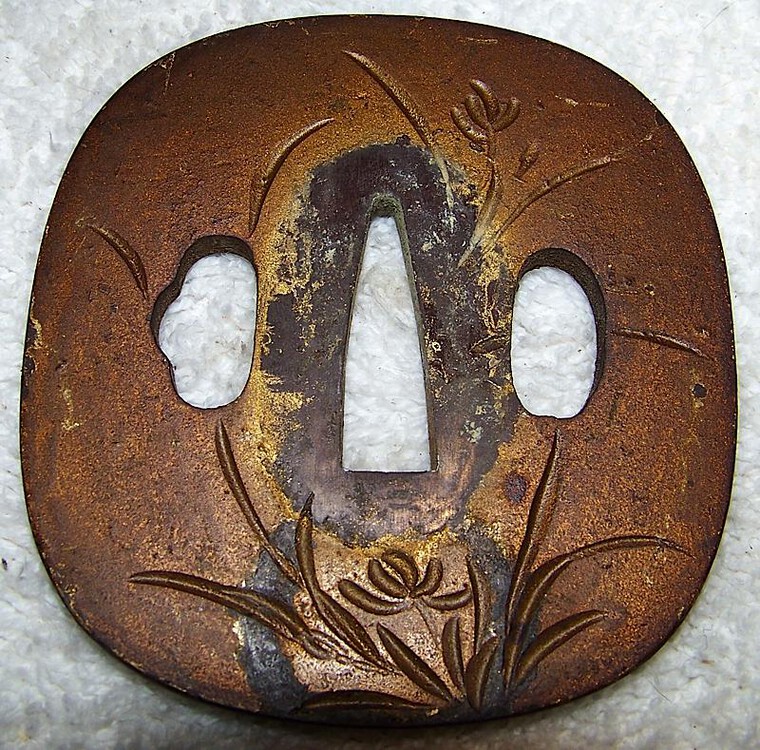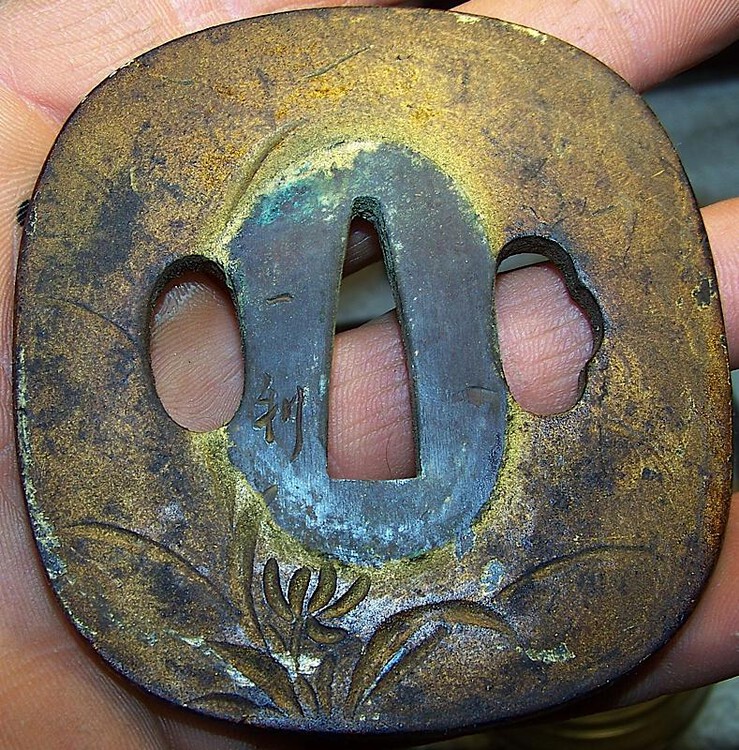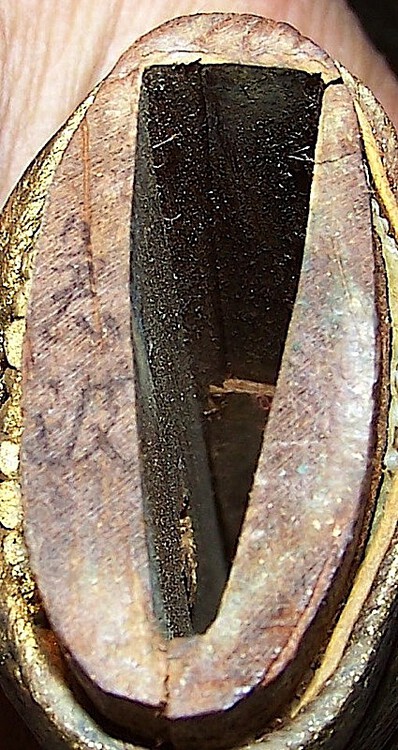
Pavel
Members-
Posts
29 -
Joined
-
Last visited
Content Type
Profiles
Forums
Events
Store
Downloads
Gallery
Everything posted by Pavel
-
Unokubi Zukuri and Kanmuri-otoshi
Pavel replied to Pavel's topic in General Nihonto Related Discussion
Thank You very much that really helps. The blades on the first thread are beautiful. According to your other link, I have a U-No-Kubi-Zukuri, without a yokote. I am hoping that the kanji on the inside of the saya will shed some light on the maker and tradition. http://www.thejapanesesword.com/forum/v ... p=810#p810 Thanks again, Pavel -
Hiya All, I was wondering if I could get some clarification on the difference between Unokubi Zukuri and Kanmuri-otoshi. In the connoisseurs book it says that a U-no-kubi-zukuri can either have a yokote or not. Other sources (http://ww2.zombieinitiative.org/node/5013 )says that if the unokubi zukuri does not have a yokote, it is a kanmuri-otoshi. However the kanmuri-otoshi does not flare back out to the kasane of the munemachi, so the second source must be wrong? Also is there a clear basic difference between a unokubi zukuri, and a nagamaki naoshi? Thanks for any information, Pavel
-
Thank You, I really appreciate any information. Thanks, in this case 'Saku' means 'made by'? I just received an email from H.A. Watson(translator of the Nihon To Koza). He said "The writing on the inside of the scabbard appears to be that of the person who reshaped the sword. That was a naginata, and has been made into a wakizashi." The date appears to be a month in 1857, but the name of the month is a bit smeared. The other three kanji appear to me to say BASHOU ARATAMERU, meaning changed by a person called Bashou. In this case, shou ryhmes with show." Guess that would make the sword that was in the saya a naganata-naoshi? Pavel
-
Hello All, Hope you are having wonder-filled days. I have been having a lot of enjoyment studying the Yamato tradition. Don't know if I have learned anything yet, but it is a lot of fun. I took the duct tape off an old saya, it had totally been covered with old style black duct tape. Taking the tape off the saya fell apart, does not look like it was ever glued together. Inside was this: This is the inside of one side and the outside of the other, showing two kurikata slots? and a hook? The top The bottom, you can just see the tip of the blade cutout. I am having the hardest time with kanji, and this seems a more stylized script than what I have seen. Can anyone help with the translation? Pavel
-
Thank You Brian, that means a lot to me coming from you. It was talking to you, Morita san and a few others that convinced me to learn traditionally. I take some solace in the fact I have now spent more on my education and books, than I ever did on a sword. Hope it is alright to lurk and learn a while. Pavel
-
After talking with my Sensei, I feel bad about asking for this blade to be Kantei. He won't even look at it, told me I shouldn't be either. I apologize for offending your eye, I am learning as fast as I can. Can't buy anymore blades until I learn a lot more than I know now.
-
Hello Gentlemen, I have another blade I would like to show you, think you might like it better than the last one. Do not think it is a wartime blade, maybe you can tell me for sure. Wakizashi 65.5cm/25.8" total, nakago 13cm/5.11" to notch 52.5cm/20.66" cutting edge Straight hamon? 3cm/1.18" wide at the bottom of the blade and 2cm/0.78" wide at the tip. 2cm/0.78" bend in the blade. Might have had a mei at one time but the rust and corrosion is pretty bad. Have always worn gloves when handling this blade, not used anything buy choi oil on it. Hope I did this right. Thank You, Pavel
-
Thanks, I never would have thought of flash cards. Pavel
-
Hello Guys, I was just going to thank the guy who said "it was a nice, interesting and informative post" And now it is gone. Anyway Thanks whoever it was. Hope the topic isn't closed totally. I didn't want to highjack someone else's post, or start a new one just to ask a quick question. Been told to get a book on Kanji. When I went to look for one, I was overwhelmed by the selection available. Would someone be so kind as to suggest one, not too expensive? The simplest would be the best for me, like "Kanji for dummies" or something along those lines. Thank you, Pavel
-
Morita san, The blade reads Kanenami, and I thank you very much for telling me that. Please have a restful evening Pavel
-
Morita san, Thank you very much for the time and the compassion spent in dealing with a newbe. It is important to me to know all available about this, and other swords in my possession. Who made the furniture, built the ho? and why on earth was it painted gold? To most of the board these questions are more than likely obvious or even immaterial, not so to me. I am awaiting "The Connoisseur's Book of Japanese Swords" by mail, in hopes of aiding this. Pavel
-
Thank You! Do you think it is worth getting professionally cleaned? I think you may be right, is there any official sword painted gold? Pavel
-
Hello All, Can anyone tell me anything about this tsuba? Since I know nothing at all, any information is appreciated. Pavel
-
Hello, Apologize if I have offended anyone, I mean no disrespect in any way. I fully admit to being a novice. Receiving my first sword in 1972, I have been enamoured of them since. Until now, work and other constraints have prevented me from devoting much time to learning about this. However being almost eighty physical training is behind me, so I begin to appreciate the sword as an art form. Now that I am retired I have some time, and am learning the history and development of each of the five schools of the Koto period 800 AD to 1595 AD. Being a retired woodworker I am also attempting to learn saya and ho construction. To me, my Sensei is the ultimate authority on swords, how else could it be? Hesitate to bring him any thing I have not investigated fully, my time with him is extremely valuable as he is even older than I. I appreciate, and have paid great attention to every comment made, and will say so again. If I have been disrespectful, then feel free to ban me. Otherwise please excuse my exuberance, and ignorance, it has been quite a while since I have had been this excited over something. Pavel
-
Thank you George, it helps. I finally showed photos of the blade to my Sensei, had to check here first. So far he has said that it looks like a mino blade with the characters of Kanemasa or maybe Kanetoshi. Here is the photo of the mei I sent him. Said he was leaning towards Kanemasa of which there are three mentioned in Hawley's book. He wants to see a drawing of the hamon. Every time I polish the blade it becomes a little clearer, it looks like choppy waves on a windy day. With 3/8 to 1/2 between the waves. Going to have to dust off the scanner and sharpen pencils, so it will take a day or so. Please excuse my ignorance, I am doing my best to cure it. This site is a valuable resource to me, and I appreciate every comment. Pavel
-
Thank you Adam, that is nice to hear. I would never use pikal on a Japanese polish. However pikal is a slurry form ferrite based polish with an average abrasive diameter of less than 1 micron, it is used on electron microscopes. When I asked my Sensei he said i could use it on ww2 rusty blades, but everything else I must use the Ochiku powder. My Sensei also told me "when it comes to asking questions no question is a dumb question for novices no ask , no learn" Pavel
-
Hello Brian, Yes thank you for the information, just trying to get a little more. Like why was it painted gold? All my life I have been enamoured of the asian societies, Japan especially. I am now taking a course about the Yamato Schools, in hopes of learning more about swords, their construction, and how to recognize them. Found this sword in conditions it should never have been in. It had been sanded with course sandpaper, could not see the hamon at all. Even though it is not the best sword around, it deserves better treatment than it has had. Pikal polish is a Japanese made polish for use on medical equipment and other sensitive or precious metals. http://pikal.co.jp/ My Sensei asked me one day why I even looked at inferior swords, he said it would spoil the eye for finer things. I told him that there were millions of swords taken from Japan mistreated so very badly, hidden in cupboards and closets the world over. I am looking for that one in a million national treasure, under that pile of old clothes on that rickety garage sale table. He said he approved under those conditions. So please forgive a students inquisitiveness, only trying to cure my ignorance. This is the only Kanenami I could find, do you know where else I might look? http://nihontoclub.com/smiths/KAN1717 Thank You, Pavel
-
Hello All, I have been polishing this sword with pikal polish and the hamon is beginning to show. The hamon is changing along the blade sometimes peaked, sometimes smooth and at times almost straight. It is a very interesting sword to me, but then I don't know much. Many things just don't fit. The mekugi ana looks punched not drilled, and one side is smaller than the other. There is a single dot stamped in the top of the nakago on the mei side. The tsuka is signed, also the tsuba. The fittings look to be cast, however there is a shim in the back of the fuchi and with a 10x loop you can see a seam. All the koshirae have been painted with what looks like gold paint, the original ito looks brown. The menuki is a wine gourd with a flower at the base. There is a leather seppa that looks machine stitched around the edge. The sword does not fit in the saya, which is a dull flat black. When the sword is pushed in to the habaki, the saya splits and cannot be forced together. Please let me know if any more photos will help identify this sword. Thank you for any and all comments. Pavel
-
Guess I was so excited finding out it is real I missed the translation. I have another one coming from Japan, supposedly a edo period wakizashi. Hopefully you can help me with that one also. You guys are a fantastic resource, thank you very much. Pavel
-
Excellent. I am just happy to know it is worth the couple of hundred I paid. I thought the sword might not be real but the hardware was. A good useable Japanese blade is a welcome addition. Is there anywhere I can find out what the kanji says? Thank you guys very much. Pavel
-
Hello Chris, Great, so that means it is nihonto? Just not a very good one, but made before 1948? Is it worth a polish? or are the mounts worth more than the blade? Thank you for taking the time to help me. Pavel
-
Hi Guys, Hope everyone is doing great. Glad to be back here. First time I have been able to sit down and write for months. Wondering if you learned Gentlemen would evaluate this sword. I really appreciate it. Thank You, Pavel not Pawel
-
Nice to meet you. Excuse me for offending you, it was not my intent. I will do my best not to offend you again. If you could leave me a list, so I will know better next time. Just out of curiosity who did teach Japan to make steel anyway? Be happy for no reason Pavel
-
When I check an edge on any edged item be it a chisel or sword, I look down the edge and if light reflex then it is a dull edge, If you cannot see the edge then it is sharp. I do not feel the edge for sharpness. One of the Smiths I have talked to over the years said he(cannot remember his name)was moving to Australia to make real swords. Another one said he worked at the forge in Loquan China, think his name was Zhi or something. I really have no way of checking ID over the net, but I believe it is possible to detest Government involvement enough to want to leave the country, to practice your art. Many times in my life I have cursed the governments dictating my actions and have thought of leaving the country of my birth. The U.S. government tells it's people what to eat(fda) what to drink(atf) what to smoke(dea) what to wear(dot) and what to say(fcc). Think about it. Thanks that makes sense that ersatz would be used for an inferior item or process.
-
No worries Carlo. I think it was a real nice thing to warn me of the guy, and I really appreciate it. I do like to scambait at times anyway. I took some more photos and found this: Is this an indication of a re-bent sword? SHINAE - Ripples or wrinkles in the skin steel generally due to a bent blade having been straightened. These can be anywhere on the blade (shinogi-ji, mune, etc). Here are both sides of the tip: I ran some pikal over the blade and in less than five minuets it looked like this: I think at one time it had a real polish and it would not take much to put it back on.

















